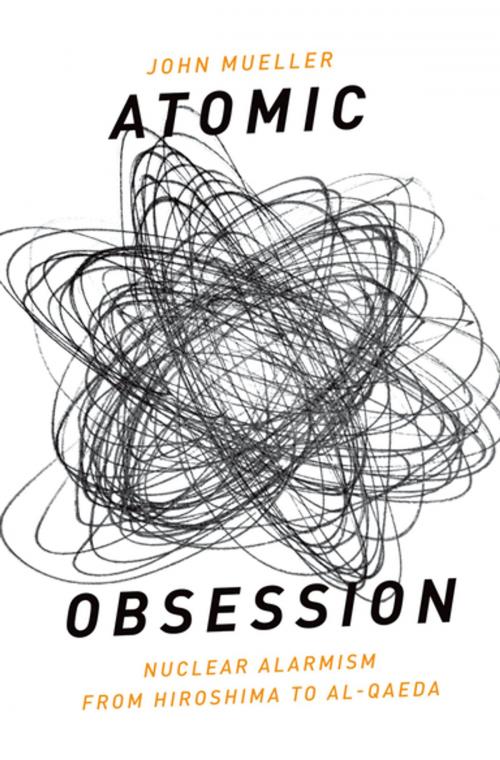Atomic Obsession
Nuclear Alarmism from Hiroshima to Al-Qaeda
Nonfiction, History, Military, Nuclear Warfare, Social & Cultural Studies, Political Science, International, International Security, Science & Nature, Technology, Military Science| Author: | John Mueller | ISBN: | 9780199745814 |
| Publisher: | Oxford University Press | Publication: | November 5, 2009 |
| Imprint: | Oxford University Press | Language: | English |
| Author: | John Mueller |
| ISBN: | 9780199745814 |
| Publisher: | Oxford University Press |
| Publication: | November 5, 2009 |
| Imprint: | Oxford University Press |
| Language: | English |
Following 9/11, Americans were swept up in a near hysteria-level fear of terrorists, especially of Islamic extremists working domestically. The government and media reports stoked fears that people living in the US have the desire and means to wreak extreme havoc and destruction. Early reports estimated slightly more than 300 al Qaeda operatives living in the United States. It wasn't long before this number became 2,000 or 5,000 domestic terrorists. As these estimates snowballed, so did spending on federal counterterrorism organizations and measures, spending which now totals over a trillion dollars. The federal government launched more covert operations in the name of fighting terrorist adversaries than they did in the entirety of the forty-five year Cold War. For each apprehension of a credible terrorist suspect, the US government created or re-organized two counterterrorism organizations. The scale of these efforts has been enormous, yet somehow they have not been proven to make Americans feels safe from what they perceive to be a massive terrorist threat. But how well-founded is this fear? Is the threat of terrorism in the United States as vast as it seems and are counterterrorism efforts effective and appropriately-scaled? It has not, statistically speaking, been efficient or successful. Only one alarm in 10,000 has proven to be a legitimate threat-the rest are what the authors refer to as "ghosts." These ghosts are enormous drains on resources and contribute to a countrywide paranoia that has resulted in widespread support and minimal critical questioning of massive expenditures and infringements on civil liberties, including invasions of privacy and questionably legal imprisonments. In Chasing Ghosts, John Mueller and Mark Stewart argue that the "ghost chase" occupying American fears, law enforcement, and federal spending persists because the public believes that there exists in the US a dire and significant threat of terrorism. The authors seek to analyze to what degree this is a true and to what degree the threat posed by terrorists in the US defends the extraordinary costs currently put towards their investigation. The chance that an American will be killed by a terrorist domestically in any given year is about one in four million (under present conditions). Yet despite this statistically low risk and the extraordinary amount of resources put towards combatting threats, Americans do not profess to feel any safer from terrorists. Until the true threat of domestic terrorism is analyzed and understood, the country cannot begin to confront whether our pursuit of ghosts is worth the cost.
Following 9/11, Americans were swept up in a near hysteria-level fear of terrorists, especially of Islamic extremists working domestically. The government and media reports stoked fears that people living in the US have the desire and means to wreak extreme havoc and destruction. Early reports estimated slightly more than 300 al Qaeda operatives living in the United States. It wasn't long before this number became 2,000 or 5,000 domestic terrorists. As these estimates snowballed, so did spending on federal counterterrorism organizations and measures, spending which now totals over a trillion dollars. The federal government launched more covert operations in the name of fighting terrorist adversaries than they did in the entirety of the forty-five year Cold War. For each apprehension of a credible terrorist suspect, the US government created or re-organized two counterterrorism organizations. The scale of these efforts has been enormous, yet somehow they have not been proven to make Americans feels safe from what they perceive to be a massive terrorist threat. But how well-founded is this fear? Is the threat of terrorism in the United States as vast as it seems and are counterterrorism efforts effective and appropriately-scaled? It has not, statistically speaking, been efficient or successful. Only one alarm in 10,000 has proven to be a legitimate threat-the rest are what the authors refer to as "ghosts." These ghosts are enormous drains on resources and contribute to a countrywide paranoia that has resulted in widespread support and minimal critical questioning of massive expenditures and infringements on civil liberties, including invasions of privacy and questionably legal imprisonments. In Chasing Ghosts, John Mueller and Mark Stewart argue that the "ghost chase" occupying American fears, law enforcement, and federal spending persists because the public believes that there exists in the US a dire and significant threat of terrorism. The authors seek to analyze to what degree this is a true and to what degree the threat posed by terrorists in the US defends the extraordinary costs currently put towards their investigation. The chance that an American will be killed by a terrorist domestically in any given year is about one in four million (under present conditions). Yet despite this statistically low risk and the extraordinary amount of resources put towards combatting threats, Americans do not profess to feel any safer from terrorists. Until the true threat of domestic terrorism is analyzed and understood, the country cannot begin to confront whether our pursuit of ghosts is worth the cost.















